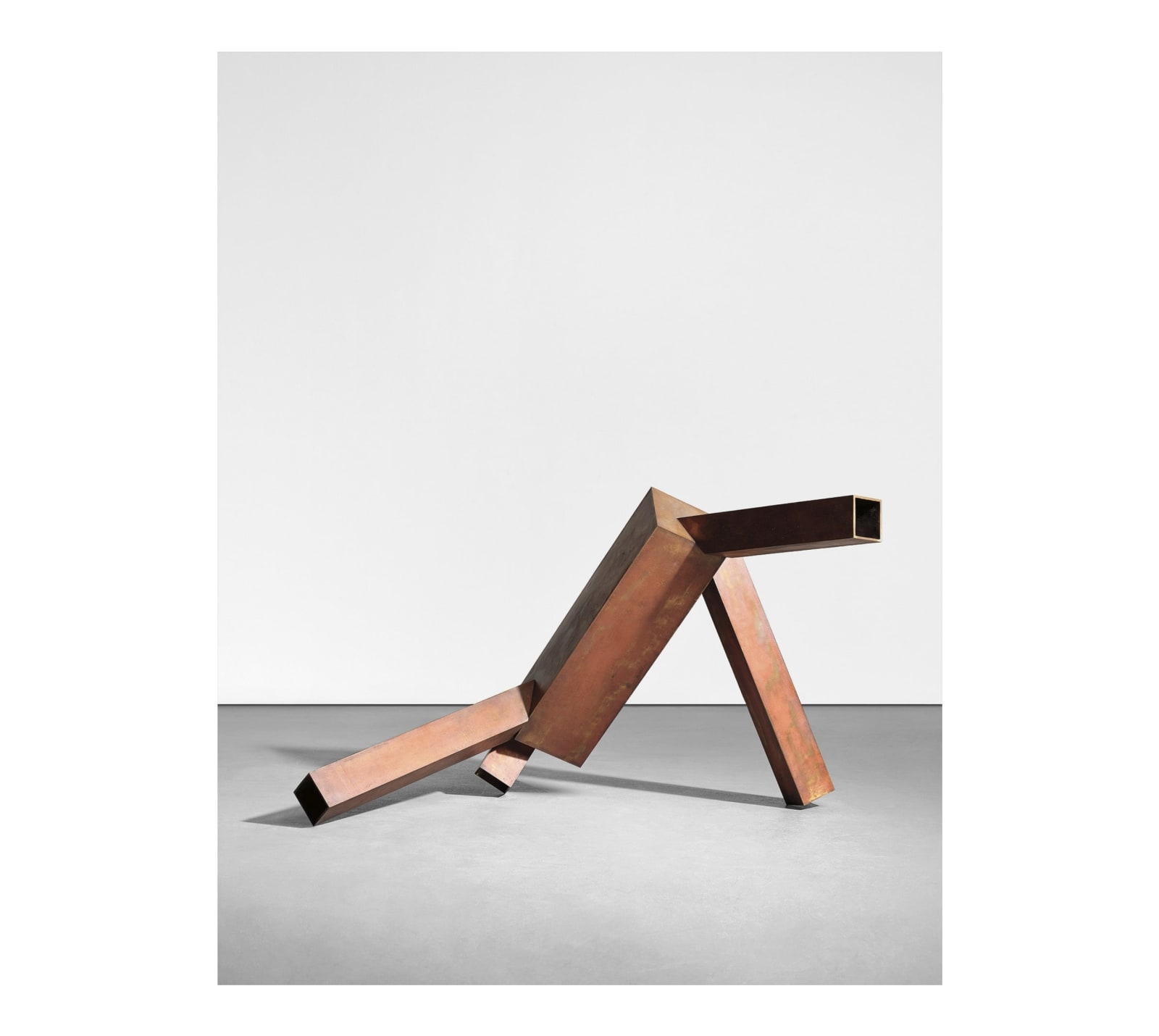
Joel Shapiro
Untitled, 1986
bronze
82.6 x 143.5 x 93.2 cm
32 8/16 x 56 7/16 x 36 11/16 in
32 8/16 x 56 7/16 x 36 11/16 in
Joel Shapiro's bronze sculpture, 'Untitled' (1986), exemplifies the artist's exploration of geometric forms and their potential to evoke dynamic, almost human-like presence. The sculpture consists of four rectangular volumes of...
Joel Shapiro's bronze sculpture, 'Untitled' (1986), exemplifies the artist's exploration of geometric forms and their potential to evoke dynamic, almost human-like presence. The sculpture consists of four rectangular volumes of varying sizes, with a large central rectangular prism to which three smaller prisms are attached. Although nonfigurative, the arrangement and movement of the prisms create a sense of a living entity performing across the gallery floor.
The question of whether Shapiro’s art humanizes geometry or dehumanizes the figure is secondary. His work often shifts between abstraction and figuration, reflecting a range of dynamic states from vigorous motion to static collapse. As K. Kertess notes, Shapiro's sculptures present a visual instability, with angles and configurations that provoke both physical and psychological disjunctions, resembling a kaleidoscope whose pieces promise resolution but never fully achieve it (Kertess, *Joel Shapiro: New Wood and Bronze Sculpture*, New York, 1998, p.6).
Since the 1970s, Shapiro has delved into how geometric forms can convey complex contemplations. Initially studying science at New York University with aspirations of becoming a physicist, Shapiro’s two years with the Peace Corps in India led him to pursue a career in art. His sculptures, which range across materials such as bronze, iron, steel, wood, plaster, and clay, often feature the rectangle as a central form. Influenced by the Minimalist movement, Shapiro redefined the role of geometry in sculpture, drawing on imagery from everyday life—like chairs, bridges, and human figures—reduced to their essential forms. His work reflects the influence of peers such as Carl Andre, Donald Judd, and Richard Serra. Shapiro's sculptures have been acquired by major museums and private collections globally and have been displayed in prominent sculpture gardens and courts alongside works by artists like Louise Bourgeois, Scott Burton, Alexander Calder, Mark di Suvero, and Ellsworth Kelly.
The question of whether Shapiro’s art humanizes geometry or dehumanizes the figure is secondary. His work often shifts between abstraction and figuration, reflecting a range of dynamic states from vigorous motion to static collapse. As K. Kertess notes, Shapiro's sculptures present a visual instability, with angles and configurations that provoke both physical and psychological disjunctions, resembling a kaleidoscope whose pieces promise resolution but never fully achieve it (Kertess, *Joel Shapiro: New Wood and Bronze Sculpture*, New York, 1998, p.6).
Since the 1970s, Shapiro has delved into how geometric forms can convey complex contemplations. Initially studying science at New York University with aspirations of becoming a physicist, Shapiro’s two years with the Peace Corps in India led him to pursue a career in art. His sculptures, which range across materials such as bronze, iron, steel, wood, plaster, and clay, often feature the rectangle as a central form. Influenced by the Minimalist movement, Shapiro redefined the role of geometry in sculpture, drawing on imagery from everyday life—like chairs, bridges, and human figures—reduced to their essential forms. His work reflects the influence of peers such as Carl Andre, Donald Judd, and Richard Serra. Shapiro's sculptures have been acquired by major museums and private collections globally and have been displayed in prominent sculpture gardens and courts alongside works by artists like Louise Bourgeois, Scott Burton, Alexander Calder, Mark di Suvero, and Ellsworth Kelly.
Provenance
Paula Cooper Gallery, New York, NYPhillip Schrager, Omaha, NE
Christie's, 20th Century & Contemporary Art Day Sale, New York, 14 May 2014, lot 457
Private Collection
Phillips London, Thursday, October 4, 2018, lot 00216
Private Collection, Belgium
Exhibitions
1986, MARUANI MERCIER, October 2020 – January 2021, Brussels, Belgium
Paula Cooper Gallery, November – December 1986 (another edition exhibited), New York, NY
Join our mailing list
* denotes required fields
In order to respond to your enquiry, we will process the personal data you have supplied to communicate with you in accordance with our Privacy Policy. You can unsubscribe or change your preferences at any time by clicking the link in our emails. This site is protected by reCAPTCHA and the Google: Privacy Policy and Terms of Service apply.